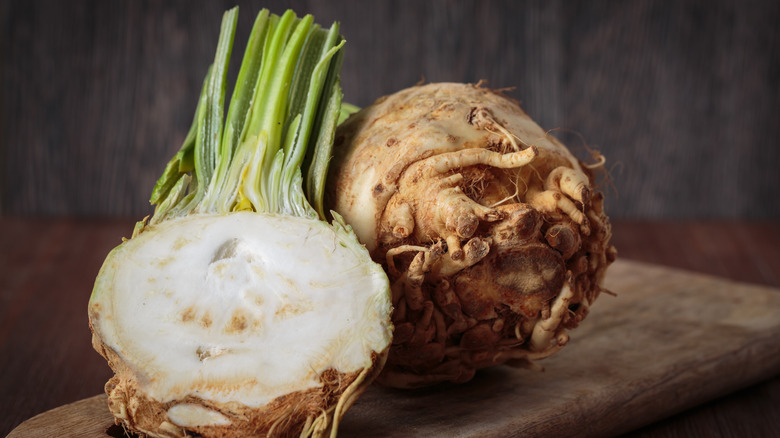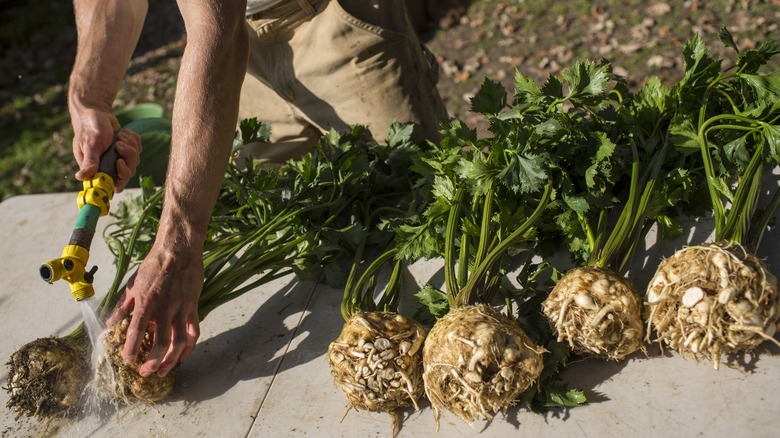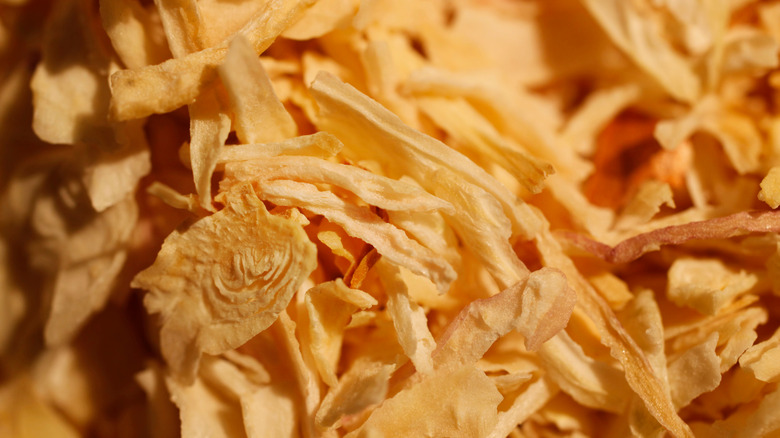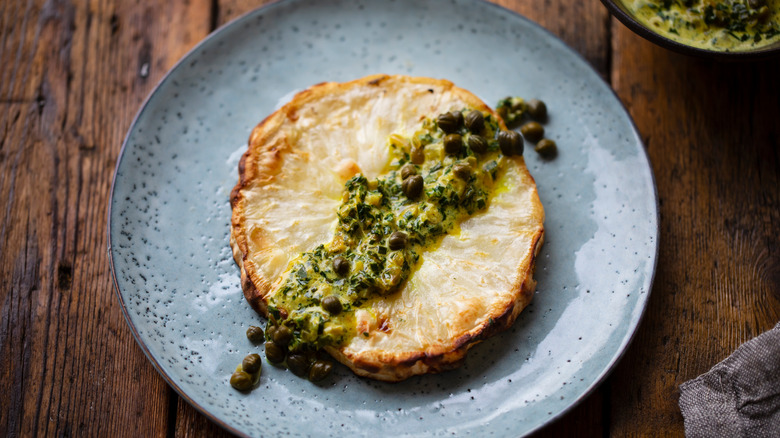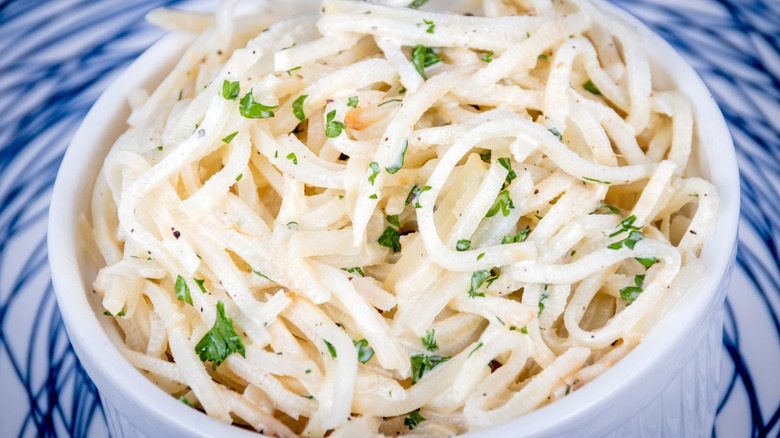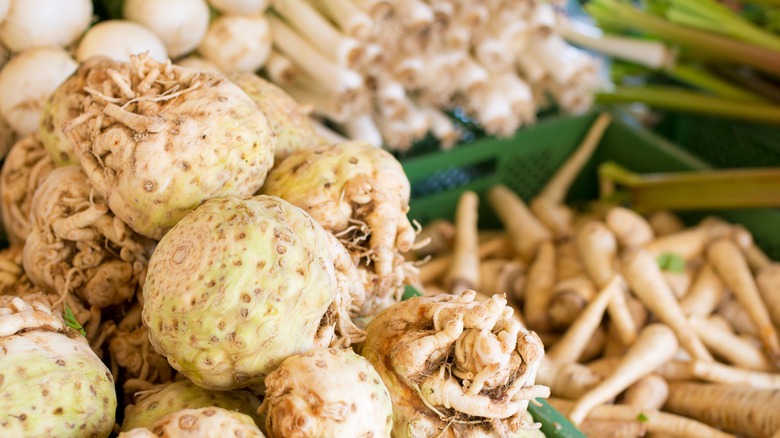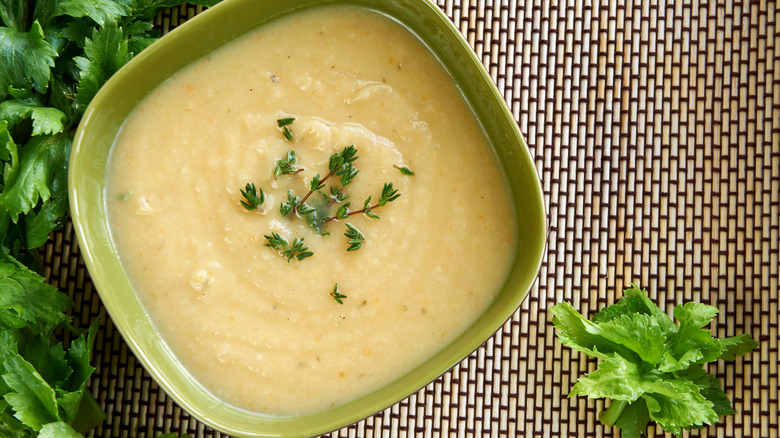Celeriac Is The Underrated Root Vegetable Popular In French Cuisine
Once winter rolls around, a variety of chunky underground vegetables start appearing on grocery store shelves. From parsnips and turnips to kohlrabi, the selection may feel overwhelming to navigate. The trustworthy potato is always an option — and seldom disappoints — but there is merit in stepping out of your comfort zone.
For a foray into less obvious but delicious wintertime vegetables, turn to celeriac. Its scientific name is a mouthful in itself: Apium graveolens var. rapaceum. But don't let that put you off, this veggie is crunchy and herbal when raw, and velvety smooth and scrumptious when cooked. It's also known as celery root — but that is actually a misnomer. Instead, it's a bulbous stem that's been cultivated in the Mediterranean for centuries.
Very nutritious, easy to cook, and malleable, it's the invigorating kind of produce that changes up a weeknight dinner or can star in an all-out weekend meal. It pairs beautifully with other winter produce and makes a tasty side to different kinds of proteins. Popular in France, it's starting to gain a warranted presence in the U.S., too. Let's dive into what the simple celeriac is all about.
What is celeriac?
Celeriac is an edible vegetable in the same family as carrots, parsley, and parsnips. Some refer to it as knob celery, or turnip-rooted celery, as well as celery root and celeriac, but it actually isn't the same plant as commonly enjoyed green celery, which can be confusing. While it is a closely related variety, celeriac is both a distinct plant and not a root, either. Instead, it's a bulbous stem, a similar botanic creation to a fennel head, and grows semi-underground. Especially prior to cleaning, the celeriac's exterior has a craggy, brown, and dirty-looking exterior. Each celeriac bulb is approximately four to five inches in diameter, and when sliced open has an attractive white, smooth flesh.
Celeriac originated around the Mediterranean, with noted early uses by civilizations in present-day Egypt, Italy, and Greece — it was even mentioned in Homer's Odyssey. Celeriac later spread and assimilated into the diets of Northern Europe, becoming especially popular in German and French cuisine during the Middle Ages. Today, celeriac is found on the shelves stateside, as well as in North Africa and South America.
Dried vs. fresh celeriac
While more commonly found fresh, with the greens still intact, celeriac is also processed into dehydrated formats. Created using an air-drying technique, dried celery root is typically sold in a flake form, although it may also be powdered. Since fresh celeriac is loved for its texture, enjoyed raw in salads, boiled, roasted, and used in soups and stews — the two products aren't usually interchangeable.
Instead, dried celeriac is revered for its savory flavor, and added like a spice to stuffings and salad dressings. When powdered, it's often mixed into a celery salt, which quickly adds a complex vegetable note when sprinkled onto a medley of dishes. Fresh celeriac will deliver the same flavors but, with its starchy consistency, have more of a textural presence in the dish. So, if a recipe calls for a raw variant of the root, it's not a good idea to substitute it. However, the exception is when it's used in a roast, soup, or stew, when the dried version can imbue the dish with the unique celeriac flavor.
What does celeriac taste like?
Although celeriac's dirt-colored exterior lends it a hearty appearance, the stem actually has a bright, herbaceous flavor. There are notes of green celery stalk with a strong undertone of parsley. The herbal flavors are accompanied by a peppery pungency, and some sweetness, which is amplified after heating. The green, leafy tops are also edible, with a parsley-like taste, and can be chopped and used like an herb. Celeriac's flavor palate is most similar to turnips, although with a lighter freshness that makes it delicious in salads.
Celeriac's texture is smooth, devoid of the pesky fibrous strands found in celery. Its balanced water content makes it adaptable to various cooking techniques, each of which lends it a different consistency. It can be pureed, fried to a crispy consistency, roasted to a balanced softness, or enjoyed raw in various shapes. Despite its resemblance to other root vegetables, celeriac has a much lower starch content than potatoes, for example. It's an exciting seasonal ingredient, open to delicious culinary experimentation.
How to cook with celeriac
Since it grows underground, celeriac takes a bit of prep work before cooking. It's necessary to thoroughly wash it, trim the root growths and leafy top, and also remove the skin with a potato peeler. Take care to check all the skin is taken off as it's tough and not very palatable. Celeriac's bright white flesh quickly discolors, so after peeling, immediately soak in lemon juice — especially when using it raw — or cook immediately.
One of the best-known celeriac dishes hails from France. It's the simple but tasty celery root rémoulade. The salad traditionally incorporates finely chopped or grated celeriac covered in a sauce of mayonnaise, mustard, and lemon and then covered with herbs and sometimes pickles. Alternatively, celeriac tastes good boiled, a delicious complement to other fall vegetables, mushrooms, or seared meat. Ina Garten recommends using it to make a side of creamy celeriac mash, as a change from potatoes. It's also particularly good as a soup, as it makes a silky smooth texture once cooked and blended, pairing well with herbs, or a warming chili kick.
Roasting is another common technique to showcase the vegetable's flavor. It works well as part of a roast vegetable medley, paired with garlic and olive oil. Celeriac can also be fried, sauteed, or grilled, and used as a substitute in most potato recipes. The food goes excellently with other winter and fall flavors, such as apples, fennel, mushrooms, and proteins like duck and pork.
Where to buy celeriac
Celeriac isn't the easiest vegetable to find in the U.S., but it is increasing in popularity. Although it can be found year-round, celeriac is a seasonal winter vegetable, reaching peak harvest from September to April. This time of year is ideal to shop for the stem at farmer's markets or select grocery stores like Whole Foods. For those fortunate enough to have a farm or garden, the plant can be cultivated during winter, with a preference for highly nutritious soil exposed to the sun. Celeriac can also be purchased online, where it's often called celery root.
When selecting your vegetables, look for celeriac that's blemish-free, not overly wrinkled, and firm to the touch. Once purchased, cut off the top and store unpeeled in the crisper drawer of the fridge for up to three weeks. Alternatively, cook and freeze for up to three months. It's best to use soon after purchase, since, with extended storage time, celeriac runs the risk of drying out.
Nutritional information of celeriac
Celeriac packs a nutritional punch, according to Healthline, delivering a variety of minerals, vitamins, and antioxidants with a low concentration of carbs. Most prominently, it offers a large dose of vitamin K, with a 3.5-ounce serving containing half of the daily requirement. Its range of health benefits includes properties that are good for heart health, bone strength, and cancer prevention. A portion also boasts 13% of the daily serving of vitamin C, which furthers the improvement of immune health, offering protection against diseases and promoting circulation. And to cap off its qualities — perfect for the wintertime — celeriac also contains illness-reducing antioxidants.
All the while, celeriac has only a small amount of carbohydrates, making it a great potato substitute. Instead, it's high in fiber, which is beneficial for promoting digestion and improving gut health. Just note that the many health benefits diminish when the stem is cooked, so for optimal effects, eat these chunky vegetables raw.
